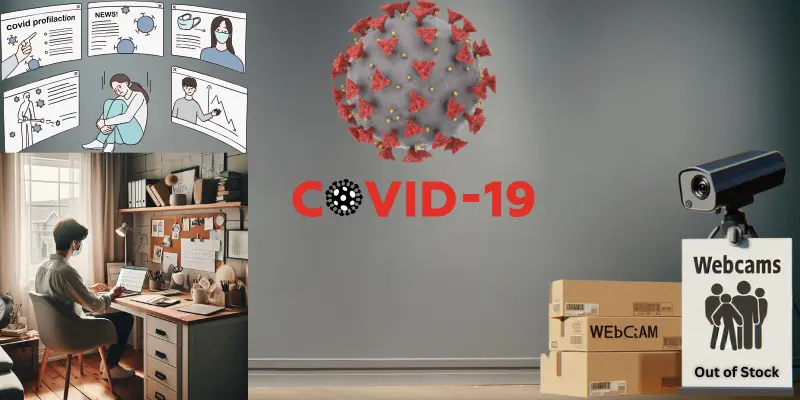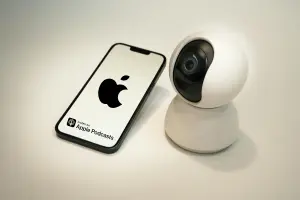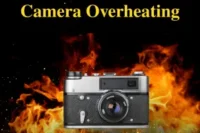Explore the History of Webcams: From Invention to Modern Use
Published: 1 Sep 2025
In today’s digital world, many of us, including you and me, use webcams because they have become integral to our lives. Whether making a video call to loved ones far away, live streaming on social media platforms, or conducting live business meetings, webcams make all this possible. But you must have ever wondered who invented the webcam and why.
In this article, I will discuss the history of webcams, who invented them, and how they came to be. Let’s get started.
Invention of the First Webcam
Video transmission and live streaming were standard in 1991 when curious researchers at the University of Cambridge in England invented the first webcam. This invention is known as the “Trojan Room Coffee Camera.” Paul Jardetzky and Quentin Stafford-Fraser developed it to monitor a coffee pot in a university break room, called the Trojan Room, to prevent time loss and indicate whether coffee was available.
The first webcam was simple and low-resolution. It was connected by a wire under the office floor and provided a live video feed that captured three frames per minute. His team developed this using his coding.
After a year of dedicated teamwork, they successfully connected the webcam to the Internet and increased its frame rate to 1 fps.
The first webcam was used to monitor a coffee pot in real time, not to facilitate communication. However, it laid the foundation for our video communication technologies.
This means that the live streaming, video calls, and online business meetings we use today all began with that first webcam.
When Did Webcams Come Out?
Webcams transitioned from experimental tech to mainstream devices in the mid-1990s, when the first consumer webcams hit the market. However, the concept began in 1991 with the University of Cambridge’s Trojan Room coffee pot camera; webcams became widely accessible in 1994 with the release of the Connectix QuickCam.

Initially designed for Apple Macintosh computers, this pioneering product allowed everyday users to experience live video communication for the first time. With its black and white video resolution of 320×240 pixels and frame rate of 15 frames per second, the QuickCam offered a simple, affordable introduction to video technology at home.
After a year, in 1995, a Windows-compatible QuickCam was released, significantly increasing the webcam’s reach. With QuickCam’s popularity, it became clear that consumers were interested in video technology for work and staying connected with friends and family. This early access to live video communication gave rise to a new era of early video calls and basic live streaming.
As more companies understood the opportunities, The webcam market quickly evolved, resulting in models with improved resolutions and colour capabilities.
Evolution of Webcam Technology
The journey of webcam technology has been fascinating and full of progress. Webcams started as simple tools but have advanced significantly over time.
Initially, webcams were created as a research project, but these devices are now essential for online communication.
1991: The Trojan Room Coffee Camera
The first webcam, the Trojan Room Coffee Camera, was created at Cambridge University in England. It was made solely to monitor the coffee pot in the computer lab.
1994: Connectix QuickCam
The first consumer webcam launched was called Connectix QuickCam. It was a small, portable device used for video chats.
1996: Growing Popularity
In 1996, webcam technology had started gaining more popularity. Many tech companies began creating webcams, and new models were introduced in the market. These devices were mainly used for video chatting and live streaming.
Late 1990s: Webcams become a Basic Accessory
By the late 1990s, webcams had become a basic computer accessory, often included in computer bundles. They were widely used for online chats, live streaming, and video conferencing, such as MSN Messenger and Yahoo!
Due to this change, webcams have become an essential tool for personal and business communication, paving the way for virtual connections.
2000s: Integration into Laptops and HD Features
In the early 2000s, webcams began to be built into laptops and all-in-one computers, making webcams easier to use for people.
During this time, the quality of webcams improved, with features like autofocus, noise cancellation, and even HD resolution becoming standard.
2010s: The Generation of HD and Advanced Features
In the 2010s, HD (720p and 1080p) webcams became widely available. These webcams provide a crystal clear and sharp image, which has significantly improved the experience of video calls and recordings.
New features, such as Facial Recognition, Virtual Background, and Advanced Light Correction, were added during this period, making webcams ideal for video conferencing, content creation, and streaming.
2020: Webcam in Demand During the COVID-19 Pandemic

The COVID-19 pandemic dramatically increased the demand for webcams. When people had to work from home during the pandemic, the use of webcams for business meetings, online classes, and social gatherings increased significantly.
This led to a shortage of webcams in stores and forced manufacturers to ramp up production quickly.
2021–2025: 4K, 8K, and Smarter AI-Powered Webcams
By 2025, webcams have reached a whole new level. While 4K resolution became the standard in earlier years, 8K recording is now available in high-end models, offering crystal-clear detail for professionals and content creators.
AI features have also advanced. Beyond auto-framing and background blur, 2025 webcams now include:
- Gesture and voice controls for hands-free use.
- Augmented reality (AR) backgrounds instead of basic blur.
- Smarter low-light correction with AI-driven sensors.
Privacy and security remain a priority, with webcams offering built-in shutter covers, encrypted video streams, and voice-based access controls to ensure safe usage.
Webcams are no longer just for video calls—they are now widely used in remote work, education, healthcare, live streaming, and even VR/metaverse platforms.
Old Webcams vs. Modern Webcams: Key Differences

Here’s the difference between old webcams and modern webcams
| Old Webcams |
|---|
|
| Modern Webcams |
|---|
|
Webcam Innovations Across Industries
These innovations make webcams more versatile and useful in video conferencing, remote work, telemedicine, and online education.
1. Remote Work and Communication:
Webcams have transformed how we operate remotely, making visual communication and collaboration simple. Zoom and Microsoft Teams have become essential tools for businesses, allowing workers to connect face-to-face with their company, even from different locations.
The most significant advantage was observed during the COVID-19 pandemic when people conducted business meetings from home using webcams. Video conferencing through webcams has made remote work more efficient and personal, bridging the gap of physical distance and improving communication.
2. Education
Webcams have played an essential part in the rise of virtual classrooms. They allow real-time contact between teachers and students, making online learning more exciting and interactive. Educators can use webcams to deliver live lectures, virtual office hours, and interactive discussions that change the traditional classroom setting. It has made education available to students worldwide, regardless of their physical location, and has allowed continuous education even during difficult times.
3. Healthcare
Webcams have induced the growth of telemedicine by facilitating remote consultations, medical follow-ups, and mental health sessions. Doctors can now perform visual assessments and check-ins without an in-person visit, which is particularly beneficial for patients in rural or underserved areas. This expansion of healthcare has made webcams an invaluable tool for modern medicine, improving global convenience and patient care.
The Tower of History Webcam: A Modern Icon
The Tower of History webcam is a fantastic way to view the sights of Sault Ste. Marie, Michigan, without actually being there. This webcam is mounted on the Tower of History and provides a live view of the city and its famous Soo Locks, where large ships pass through, connecting Lake Superior to the other Great Lakes.
Whether you are in the city or watching from anywhere in the world, if you can’t watch the live view for some reason, this webcam offers the first view of the unique activity in the area.
Webcams are not only for online communication and streaming, but they have also become a popular tool for tourists and history lovers who want to explore Sault Ste. Marie’s rich heritage through a virtual tour. By watching it, you can see boats and freighters navigating the waterways, notice the changing seasons, and appreciate the landscape from a new angle. It’s just like experiencing the beauty and journey from your home.
Webcams like the Tower of History promote tourism and help people feel connected to different places, even if they can’t go there. This webcam serves as a modern gateway, reducing the distance between distant locations and making exploration possible for everyone, allowing you to experience any place live from anywhere.
| Facts and Historical Highlights |
|---|
Here are some interesting facts and historical highlights about webcams.
|
Conclusion
So guys, in this article, I’ve covered the history of webcams in detail. From a coffee pot camera in 1991 to today’s 8K AI-powered devices, webcams have come a long way. They have evolved from a small lab experiment into an everyday tool that supports remote work, online learning, healthcare, streaming, and even virtual reality.
With every new upgrade, webcams have become smarter, more secure, and more immersive, shaping the way we connect in our digital world.
👉 Stay connected with us for more webcam insights, tips, and updates—and don’t forget to share this article with anyone curious about the evolution of webcams!
Frequently Asked Questions (FAQs)
Here are some of the most frequently asked questions related to the history of the webcam:
The first webcam was invented to monitor a coffee pot, helping researchers avoid the frustration of finding an empty pot.
The first webcam was used to monitor a coffee pot at the Trojan Room at Cambridge University.
Webcams have become essential in several industries, including:
- Remote Work and Business (for virtual meetings)
- Education (for online classes)
- Healthcare (for telemedicine)
- Security and Surveillance (for monitoring)
- Content Creation and Streaming (for live streaming)
Webcams became popular in the late 1990s as faster internet made video calling and live streaming more accessible.
Their use grew rapidly in the 2000s with the rise of video chat platforms and surged again during the COVID-19 pandemic.
Quentin Stafford-Fraser and Paul Jardetzky invented the first webcam in 1991 at the University of Cambridge to monitor a coffee pot in their computer lab.
The first commercially produced webcam was the QuickCam, developed by Connectix in 1994. Initially designed for Apple Macintosh computers, it connected via serial port and provided grayscale images at a resolution of 320×240 pixels. Priced around $100, the QuickCam was a pioneering product that introduced webcam technology to a broader audience.
Yes, webcams are still very important. Phones are great for casual use, but webcams are better for long meetings, streaming, and professional video. They also connect easily with PCs, laptops, and VR setups.
Yes, 8K webcams give sharper and more detailed video than 4K. They are mostly used by streamers, content creators, and professionals. For everyday use, 4K is still more than enough.
The word “webcam” stands for web camera. It is a camera that connects to a computer and streams or records video over the internet. People use it for video calls, live streaming, and online meetings.
A webcam is an input device. It records video and sends it to a computer or software program. The computer then processes this video so it can be viewed, shared, or streamed online.

- Be Respectful
- Stay Relevant
- Stay Positive
- True Feedback
- Encourage Discussion
- Avoid Spamming
- No Fake News
- Don't Copy-Paste
- No Personal Attacks

- Be Respectful
- Stay Relevant
- Stay Positive
- True Feedback
- Encourage Discussion
- Avoid Spamming
- No Fake News
- Don't Copy-Paste
- No Personal Attacks





